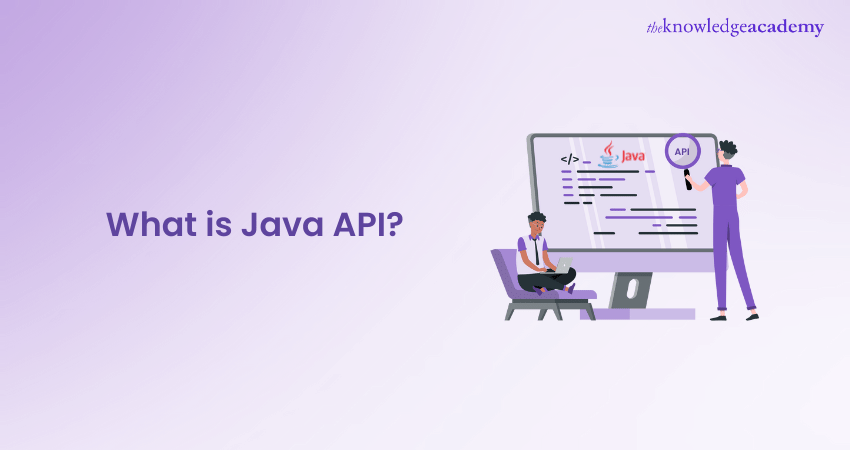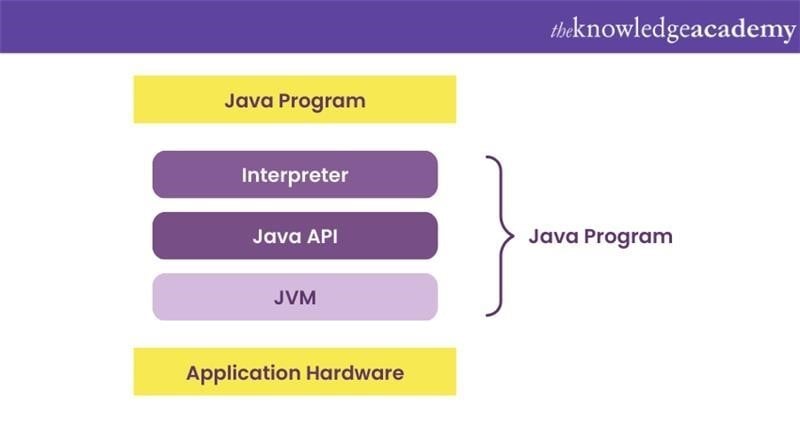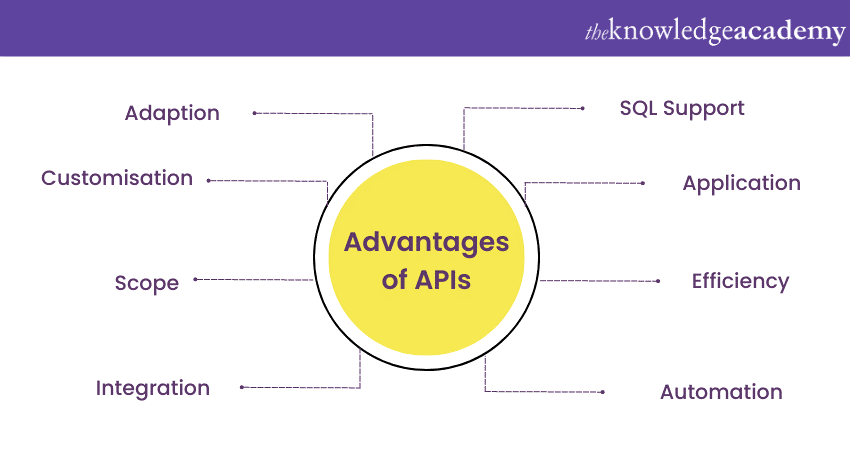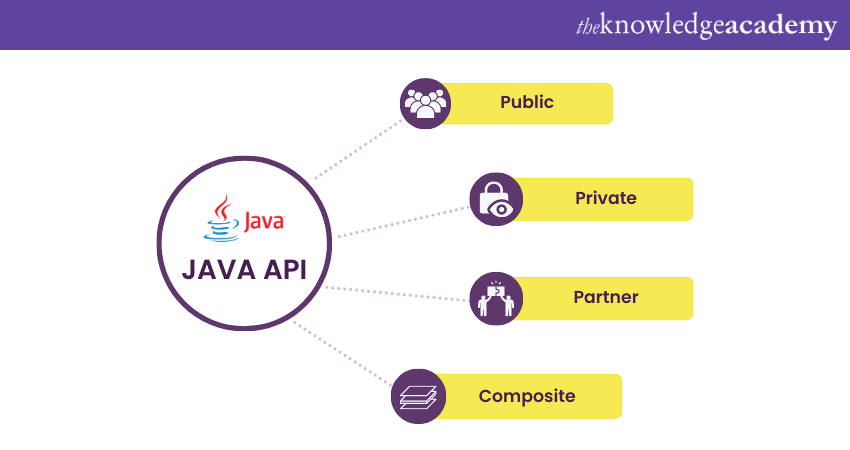We may not have the course you’re looking for. If you enquire or give us a call on +46 850282424 and speak to our training experts, we may still be able to help with your training requirements.
Training Outcomes Within Your Budget!
We ensure quality, budget-alignment, and timely delivery by our expert instructors.

Imagine having a toolkit that lets you connect powerful applications, unlocking endless possibilities for your projects. That’s exactly what Java API offers – a gateway to integrating diverse software functionalities seamlessly while safeguarding essential resources.
With its robust cross-platform capabilities, Java stands tall as one of the most popular programming languages worldwide, with 30.55% of developers harnessing its power, according to Statista. However, to truly unleash Java’s potential, mastering its APIs is key. In this blog, we’ll dive into the world of Java API, exploring its types, examples, and why you should use it to elevate your development game.
Table of Contents
1) What is Java?
2) What is Java API?
3) Users of Java API
4) Importance of Java API
5) Types of Java API
6) The Protocols of API Service
7) The Advantages of APIs
8) Conclusion
What is Java?
Java is a versatile, Object Oriented Programming language developed by James Gosling and his team at Sun Microsystems in the mid-1990s. It is known for its "Write Once, Run Anywhere" principle, allowing Java code to run on any device with a Java Virtual Machine (JVM). Java is platform-independent, making it widely used for developing cross-platform applications. Its syntax is derived from C and C++, emphasising simplicity and readability.
Java applications are typically compiled to bytecode that runs on the JVM, providing a layer of abstraction. Java is extensively used in Web Development, Android mobile applications, enterprise solutions, and more.
What is Java API?
Application Package Interface (API) is an essential component of Java programming language wrapped with the Java Development Kit (JDK). APIs can be considered as a bundle of essential methods and classes provided by Java libraries.
JAVA API is a set of frequently used prewritten programs often used to save time. Due to their widespread use in the developer community, Java APIs are available by default without additional packages or installation. Imagine a machine, like a drill, frequently used to create a larger machine. A drill is a tool designed from components, but its frequent use makes it indispensable. As a result, rather than creating a drill from scratch each time, you have it stored in your toolbox, pre-made for use. Application Package Interface or API in Java acts similarly.
Architecture of Java API

To grasp the significance of APIs in Java, let’s first explore how Java API is integral to the Java architecture. Java is one of the most platform-independent programming languages. APIs are essentially a bundle of methods and classes provided by Java libraries. The JRE acts as an intermediary layer between the OS and the Java Program.
JRE achieves this using Java Virtual Machine, which makes Java Programs portable. Java API is another component of the JDK that acts as a connective layer between your system and a Java program. However, the scope of API is not limited to the usage of innate functions in your system but also other applications. Using the proper API, you can use a Java program to interact with an application.
Explore the intricacies of Java with our Java Courses and discover its vast potential today!
Users of Java API
Java APIs are utilised by various categories of developers based on their roles and project requirements. Three main types of developers commonly use Java APIs:
a) Internal Developers: Internal developers employ APIs that are specific to their organisation and are not accessible outside it. Applications using internal APIs include those focused on Business-to-Business (B2B), Business-to-Cunsumer (B2C), Application-to-Application (A2A), and Business-to-Employee (B2E). Examples of such applications are Gmail, Google Cloud VM, and Instagram.
b) Partner Developers: Organisations establish and employ partner APIs made available to partner developers through API keys. Applications using partner APIs cover areas such as B2B and B2C. Examples include Finextra and Microsoft's Open API Initiative.
c) Open Developers: Leading companies may offer access to their APIs in an open-source format, allowing developers to use them with an API key to ensure legal usage. Java API is an essential tool in software development as it allows developers to leverage Java’s full potential. Examples of such applications are Twitter and Telnyx.
Importance of Java API
Java API is a necessary tool in Software Development as it allows you to use Java to its maximum potential. Since Java APIs are essentially prewritten Java programs, which can be invoked with keywords, reducing the manual work a developer needs to do. This makes the process of creating applications significantly easier.

Application Package Interface allows your applications developed in Java to interact successfully with third-party services. An example would be having a Google-based Login built into your application. APIs allow you to perform these tasks with minimal effort. You can achieve high-quality customisation on your applications with the use of API.
Java APIs minimise the manual work needed. This is achieved with high-level automation API provided within a computer. As a result, this reduces the time required to complete a task. This is possible because the lack of human interaction reduces the possible errors in the workflow.
APIs in Java allows you seamless integration between two different applications. Consider how a food delivery app lets you track your order’s location in real-time. Logically it's unlikely that the organisation behind that food delivery application has their satellite. Yet they can deliver the location of your order by using other applications like Google Maps.
API allows your application to make use of the benefits of other applications. In the case of a food delivery application, using the functionality of applications like Google Maps is a common practice. However, this doesn’t mean Google can give the delivery application access to its entire resource. This is where Java API acts as a layer, allowing the connection between two applications.
Explore Java Interview Questions and Answers to excel in your next interview!
Types of Java API
Java APIs can be categorised based on their access levels. Each of these APIs has its own use cases in development.

APIs can be divided into different categories based on their access levels. Each of these APIs has its own use cases in development.
1) Public API: These APIs do not have strict limitations on who uses them. They are generally a part of the Java Development Kit and are also referred to as the “Open API.”
2) Private API: These APIs are developed by organisations with restricted access to specific users. Think of the creator as an organisation; then the API will be accessible to the employee of the said organisation. They are also known as “Internal APIs”.
3) Partner API: These Application Package Interfaces are developed by an organisation for strategic purposes. These are third-party APIs in nature and are used for business operations.
4) Composite API: These Application Package Interfaces are considered microservice because they are a collection of many different APIs.
API Types Based on Service
Application Package Interfaces can be further categorised based on the services and uses. For example, another way to categorise a Java API is by considering its ability to manipulate data.
1) Internal API Services: These Application Package Interfaces are used to operate on complex data and internal processes. They are created within a specific organisation, and their capabilities and services specifically extend to that organisation.
2) External API Services: These Application Package Interfaces are integrated into a pre-existing application by the developers. They are open-source in nature.
3) User Interface Services: These API services are used by the developer to build a User Interface (UI) across different platforms. They are open source in nature and are frequently used across platforms like electronics, mobile and computers.
4) CRUD: It's an acronym for Create, Read, Update and Delete. These APIs are used frequently with data storage units to manipulate data. Some common examples of CRUD use cases would be in Relational Database Management Systems (RDBMS) and Software as a Service (SaaS). It makes frequent use of tools like Java Database Connectivity (JDBC).
What is REST API in Java?
Representational State Transfer (REST) API, also called RESTful Application Package Interface, is a frequently used API in Java. REST API allows information exchange between two different systems through the internet while maintaining security. An everyday use case of REST API is in banking, where a banking system will take data from the accounting system to generate payslips.
The Protocols of API Service
Specific rules and protocols govern Java APIs, which may vary across different implementations. Let's explore the example of the RESTful API service protocol to understand its fundamental principles.
a) Stateless: A RESTful API adheres to a client-server architecture, necessitating a stateless approach. This means that each request from a client to the server is independent and does not rely on previous requests.
b) Uniform Interface: In a RESTful API, the entities involved are the server and clients. A consistent interface is maintained using the Hypertext Transfer Protocol (HTTP) to facilitate global-scale applications. Uniform Resource Identifiers (URIs) allocate the necessary resources.
c) Client-server: The RESTful API employs a client-server model designed to be fault-tolerant. The client and server operate independently, ensuring that changes made at one end do not impact the other.
d) Cache: To enhance real-time performance, a RESTful API incorporates caching. This feature allows the application to store intermediate responses, leading to faster execution.
e) Layered: The architecture of a RESTful API is structured in layers. These layers are loosely coupled, ensuring independence from each other. Each layer contributes to a distinct level of hierarchy and supports encapsulation.
Create fascinating desktop application with Java Swing Development Training!
The Advantages of APIs
Java APIs offer several key advantages that contribute to the efficiency, functionality, and adaptability of applications:
a) Extensive SQL Support: Java APIs provide comprehensive SQL support services to user applications through a component-based interface, enhancing database interactions.
b) Application Accessibility: APIs in Java offer seamless access to a wide range of an application's critical software components, facilitating efficient service delivery.
c) Efficiency: Java APIs contribute to high application efficiency by enabling rapid deployment. Additionally, the generated data is consistently available online, promoting accessibility.
d) Automation: APIs enable automated processes, allowing computers to upload, download, update, and delete data autonomously without the need for human interaction.
e) Integration: Java APIs integrate seamlessly into applications and websites, offering smooth user experiences with dynamic data delivery.
f) Scope: Java APIs play a crucial role in making websites, applications, and information accessible to a broad audience, catering to diverse users.
g) Customisation: Developers and businesses leverage Java APIs to build applications that offer personalised user interfaces and data, enhancing user engagement.
h) Adaptability: Java APIs exhibit high flexibility and adaptability, easily accommodating feature updates and changes to frameworks and operating environments.
Conclusion
Java API is a collection of essential classes, interfaces, and packages. As we conclude, we hope you’ve gained insights into the importance, usage, and types of Java APIs. Feel free to explore more of our resources to further enhance your Java development skills and stay ahead in your coding journey! Embrace the power of APIs to elevate your projects and drive innovation.
Build Java-based web applications with Web Development Using Java Training!
Frequently Asked Questions

Yes, Java is great for building APIs due to its robust frameworks like Spring Boot and Jakarta EE. It offers strong community support, scalability, security features, and extensive libraries, making it an ideal choice for both RESTful and SOAP-based APIs.

Yes, Java is better for enterprise-level APIs needing high performance and security, with frameworks like Spring Boot. Python is ideal for quicker development, simplicity, and flexibility, using frameworks like Flask or Django. Choose based on project scale, performance needs, and development speed.

The Knowledge Academy takes global learning to new heights, offering over 30,000 online courses across 490+ locations in 220 countries. This expansive reach ensures accessibility and convenience for learners worldwide.
Alongside our diverse Online Course Catalogue, encompassing 17 major categories, we go the extra mile by providing a plethora of free educational Online Resources like News updates, Blogs, videos, webinars, and interview questions. Tailoring learning experiences further, professionals can maximise value with customisable Course Bundles of TKA.

The Knowledge Academy’s Knowledge Pass, a prepaid voucher, adds another layer of flexibility, allowing course bookings over a 12-month period. Join us on a journey where education knows no bounds.

The Knowledge Academy offers various Java Courses, including Java Programming, JavaScript for Beginners, and Introduction to Java EE Training Course. These courses cater to different skill levels, providing comprehensive insights into Java Developer Job Description.
Our Programming and DevOps blogs cover a range of topics related to Java, offering valuable resources, best practices, and industry insights. Whether you are a beginner or looking to advance your Java Programming skills, The Knowledge Academy's diverse courses and informative blogs have you covered.
Upcoming Programming & DevOps Resources Batches & Dates
Date
 Java Programming
Java Programming
Mon 20th Jan 2025
Mon 3rd Mar 2025
Mon 12th May 2025
Mon 14th Jul 2025
Mon 22nd Sep 2025
Mon 17th Nov 2025







 Top Rated Course
Top Rated Course



 If you wish to make any changes to your course, please
If you wish to make any changes to your course, please


